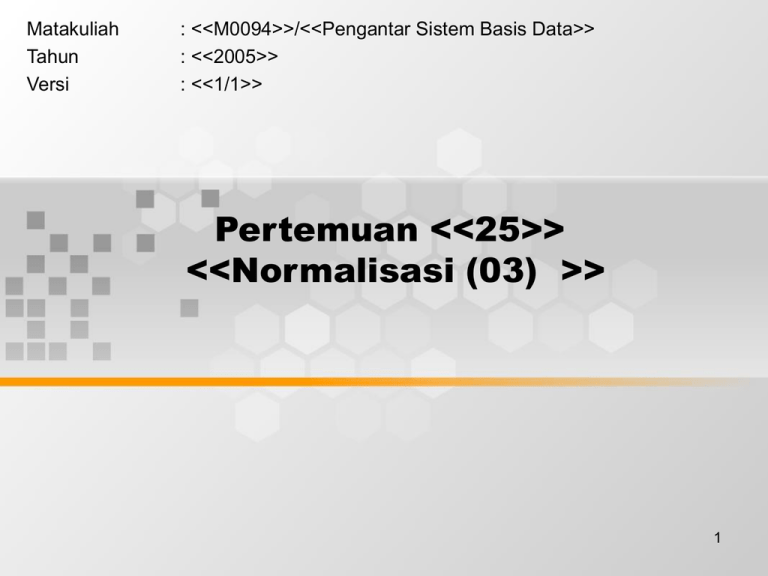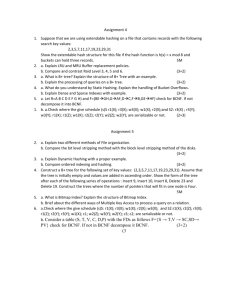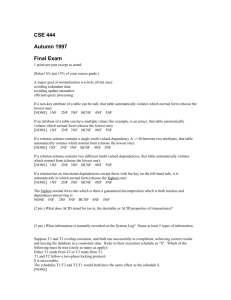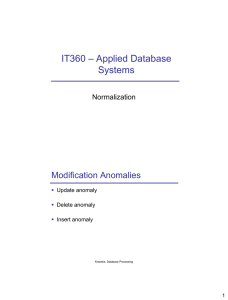Matakuliah : <<M0094>>/<<Pengantar Sistem Basis Data>> Tahun : <<2005>>
advertisement

Matakuliah Tahun Versi : <<M0094>>/<<Pengantar Sistem Basis Data>> : <<2005>> : <<1/1>> Pertemuan <<25>> <<Normalisasi (03) >> 1 Learning Outcomes Pada akhir pertemuan ini, diharapkan mahasiswa akan mampu : • Mahasiswa dapat Memisahkan data sampai pada bentuk normal BCNF 2 Outline Materi • Boyce Codd Normal Form (BCNF) 3 Chapter 13 (lanjutan pert 24) Normalization Transparencies 4 Boyce–Codd Normal Form (BCNF) Based on functional dependencies that take into account all candidate keys in a relation, however BCNF also has additional constraints compared with general definition of 3NF. BCNF - A relation is in BCNF if and only if every determinant is a candidate key. 5 Boyce–Codd normal form (BCNF) Difference between 3NF and BCNF is that for a functional dependency A B, 3NF allows this dependency in a relation if B is a primary-key attribute and A is not a candidate key. Whereas, BCNF insists that for this dependency to remain in a relation, A must be a candidate key. Every relation in BCNF is also in 3NF. However, relation in 3NF may not be in BCNF. 6 Boyce–Codd normal form (BCNF) Violation of BCNF is quite rare. Potential to violate BCNF may occur in a relation that: – contains two (or more) composite candidate keys; – the candidate keys overlap (i.e. have at least one attribute in common). 7 Review of Normalization (UNF to BCNF) 8 Review of Normalization (UNF to BCNF) 9 Review of Normalization (UNF to BCNF) 10 Review of Normalization (UNF to BCNF) 11 Fourth Normal Form (4NF) Although BCNF removes anomalies due to functional dependencies, another type of dependency called a multi-valued dependency (MVD) can also cause data redundancy. Possible existence of MVDs in a relation is due to 1NF and can result in data redundancy. 12 Fourth Normal Form (4NF) - MVD Dependency between attributes (for example, A, B, and C) in a relation, such that for each value of A there is a set of values for B and a set of values for C. However, set of values for B and C are independent of each other. 13 Fourth Normal Form (4NF) MVD between attributes A, B, and C in a relation using the following notation: A B A C 14 Fourth Normal Form (4NF) MVD – – – can be further defined as being trivial or nontrivial. MVD A B in relation R is defined as being trivial if (a) B is a subset of A or (b) A B = R. MVD is defined as being nontrivial if neither (a) nor (b) are satisfied. Trivial MVD does not specify a constraint on a relation, while a nontrivial MVD does specify a constraint. 15 Fourth Normal Form (4NF) Defined as a relation that is in BCNF and contains no nontrivial MVDs. 16 4NF - Example 17 Fifth Normal Form (5NF) A relation decomposed into two relations must have lossless-join property, which ensures that no spurious tuples are generated when relations are reunited through a natural join. However, there are requirements to decompose a relation into more than two relations. Although rare, these cases are managed by join dependency and fifth normal form (5NF). 18 Fifth Normal Form (5NF) A relation that has no join dependency. 19 5NF - Example 20 << PENUTUP>> Selanjutnya Pert 26 Normalisasi 21




